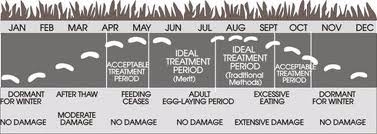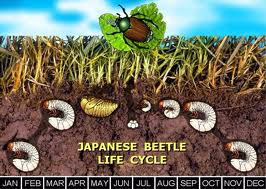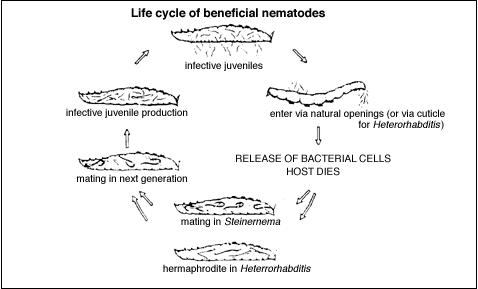Chinchbugs can be a problem on turfgrass throughout much of our area. They are so small that they can literally destroy a lawn without ever being actually observed.
Adult |
Nymphs |
Females start laying eggs in late spring and normally deposit over 200 eggs during a 20 - 30 day period. Eggs are laid in the sheaths of grass plants, or other protected places and they hatch in 7 - 10 days. The tiny red nymphs are wingless and have a white to pale yellow band across their backs. They are extremely active, have strong appetites and start feeding immediately. As they grow older, their colour gradually becomes darker and depending on temperature, they become adults in about 5 weeks. The adult chinchbug has a black body that measures about 1/5 of an inch in length and a black triangular pad separates white, folded wings.
Chinchbugs become active in warm temperatures and activity reach a peak during extended periods of hot, dry weather. The chinchbug inserts its slender beak into the grass plant and extracts fluids. Activity often starts near the reflected heat of walkways and streets but soon spreads outward into healthy turf. The most susceptible turfs are those in sunny, sloping areas and under moisture stress. As the grass turns from pale yellow to a lifeless tan, it is most often confused with drought.
Two or more generations can be produced in a growing season. First generations often complete their life cycles before the first frost. Succeeding generations hibernate in the thatch and upper parts of the soil.
How can we control Chinchbugs? Our Deluxe Program contains timely inspections and control as required.
There are three different types of grubs, June Bug, European Chafer and Japanese Beetle. Our main concern is the European Chafer.
The European chafer was first observed as a pest problem in the 1940s in New York. Most damage occurs in light, sandy soils.
White Grub |
European Chafer |
Adult
Larvae

White Grub |
Japanese Beetle |
Adult
Larvae

Nematodes are microscopic worms that are found all over the world and feed on insects.
Benefits of Nematodes:
Nematodes carry bacteria in their body that is toxic to insects. Once they seek out the insects, they enter them through their natural body openings and release their bacteria, which multiply and eventually kill their hosts. But not before the Nematodes develop into adults, reproduce, and produce offspring. A few weeks after the initial infection, the new Nematodes develop into infective juveniles, and thousands of them emerge from the dead insect and they begin to search for their new insect hosts in the soil.
It's best to apply Nematodes to moist soil when temperatures are between 15-30*C. A pre-application irrigation can be applied to moisten the soil and a post-application irrigation can be applied to wash any Nematodes to the soil surface. The post-application irrigation should be applied before spray droplets dry and must provide a tenth to a quarter inch of water to allow the Nematodes to move into the upper soil layers. Applications can be made before or even during a rainfall to wash Nematodes to the soil surface.

For a FREE estimate on our Services | ||